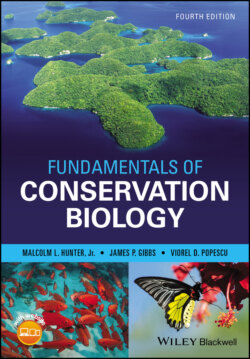Читать книгу Fundamentals of Conservation Biology - Malcolm L. Hunter Jr. - Страница 36
The Related Concepts of “Integrity” and “Sustainability”
Оглавление“Biodiversity” is only one of several concepts that have been competing for the attention of natural resource managers in recent years; it has been joined by “sustainability,” “ecosystem integrity,” “biotic integrity,” and others (Fig. 2.5).
Figure 2.5 What is the state of this Pacific kelp forest? From a biodiversity perspective we would focus primarily on having a complete set of the native species (especially any that might be in danger of disappearing from the system), as well as genetic and ecological attributes. A biotic integrity perspective would be similar, but would put more emphasis on having an appropriate density of each species and the appropriate rate of ecological processes. In terms of ecosystem integrity, the emphasis would be on the ecological processes driving this system. A focus on sustainability would center on the prospects for maintaining this system in the future.
(Ethan Daniels/Shutterstock)
Biotic integrity (or biological integrity) refers to the completeness or wholeness of a biological system, including the presence of all the elements at appropriate densities and the occurrence of all the processes at appropriate rates (Angermeier and Karr 1994), and thus it is quite similar to the concept of biodiversity. The difference is mainly a matter of emphasis. Biotic integrity emphasizes the overall balance and completeness of biological systems, while biodiversity emphasizes that all the biotic elements are present. Furthermore, biotic integrity gives almost equal weight to functions and structure, whereas biodiversity usually emphasizes structure. For example, no one could ever claim that they had increased biotic integrity by increasing the number of fish species in Clear Lake.
Ecosystem integrity (or ecological health and integrity) refers to the status of an ecosystem. “Ecosystem integrity” is generally the preferred term because the inevitable analogy between ecosystem health and human health can be misleading (Suter 1993 ; Rapport 1998). To take just one example, a forest ecosystem that is recently burned is not necessarily unhealthy. Ecosystem integrity is broader than both biotic integrity and biodiversity because it encompasses the physical environment; for example, soil erosion and sedimentation are key aspects of ecosystem integrity and it is usually evaluated in terms of ecosystem functions, rather than the suite of species that constitute the biological portion of an ecosystem (Callicott et al. 1999). From an ecosystem integrity perspective the productivity or water quality of Clear Lake might be considered as important as the species composition of the fish fauna.
Lastly, sustainability is simply the ability to maintain something over time without diminishing it. In a natural resource management context, sustaining the resources that are most directly used by people – timber, fisheries, water, energy, recreational opportunities, and so on – usually comes first (de Vries 2013). The key idea here is “intergenerational equity” or, in plainer language, not messing things up for our children and grandchildren. A related idea is tied to the term “planetary boundaries,” which refers to the environmental limits within which humanity can safely operate; according to Steffen et al. (2015) we are already exceeding the proposed sustainable planetary boundaries. Obviously conservation biologists support sustaining biodiversity but they are not all comfortable with the term, partly because it implies that the status quo is a desirable state and partly because the term is primarily associated with the instrumental value of natural resources demanded by people (Newton and Freyfogle 2005a , b). For example, sustaining the sport fisheries of Clear Lake was not linked to sustaining the native fishes.
People’s values are clearly reflected in their choices of what should be maintained and sustained. It is also true, but less obvious, that the ways we judge biotic and ecosystem integrity are also shaped by values (Lackey 2001). Proponents of the biotic integrity concept are quite explicit that their ideas about “all appropriate elements and occurrence of all processes at appropriate rates” are based on using natural systems as benchmarks, that is, those with little or no human influence (Angermeier and Karr 1994 ; Hunter 1996). For example, they would decide whether or not a particular species of catfish belongs in Clear Lake by whether it would be there without human intervention. Many biologists would share this standard, but there is nothing sacred about using a natural system as the basis for comparison. Notably, Robert Lackey (1995) has argued that “An undiscovered tundra lake and an artificial lake at Disneyland can be equally healthy.” For him the key question is whether the lake is in a desired state; that is, is it satisfying human expectations? The bottom line is that to use any of these concepts, including biodiversity, requires some kind of benchmark, and the selection of benchmarks inevitably reflects human values. Values differ among people, as we will explore in depth in Chapter 15, “Social Factors,” but the large majority of people prefer to live in a healthy world where clean air, clean water, and uncontaminated soils and food are the norm, …a world where tropical forests, coral reefs, and savannas still flourish.
